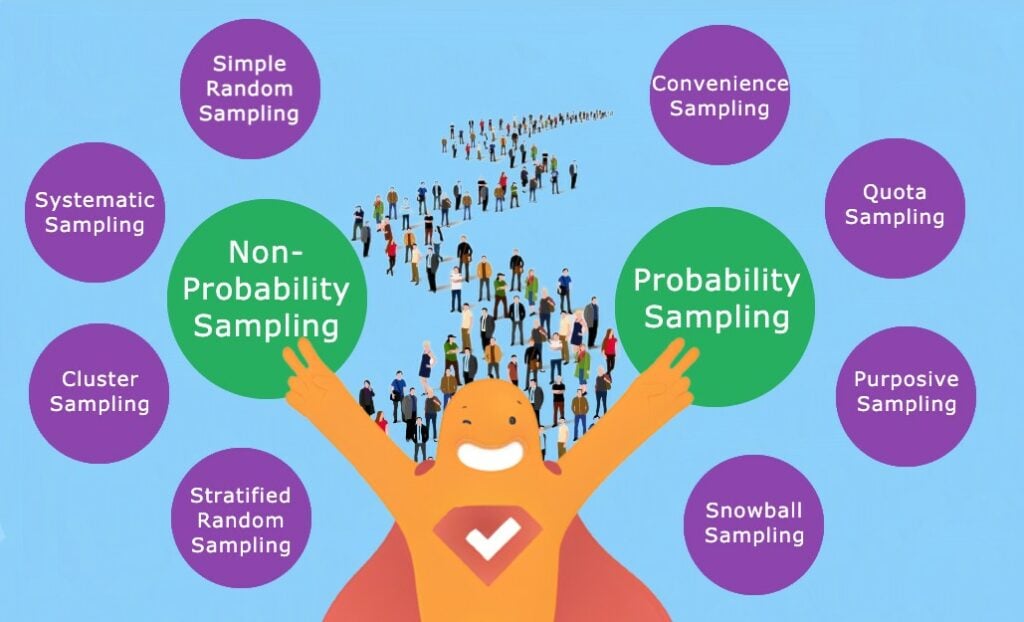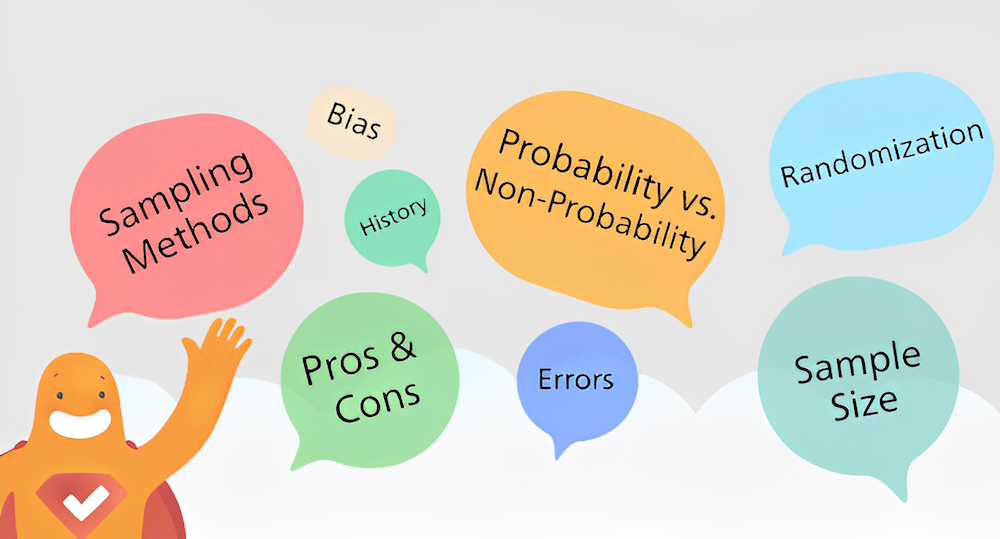Today, there are about 125 million households in the United States. To help communities and the government understand the direction the country is moving in (and much more), the Constitution requires a census. This census is designed to count every resident of the country every 10 years. So how does the U.S. Census Bureau go about surveying 125 million homes? It doesn’t. The office uses sampling to get the job done. In this blog, we’ll take a look at eight different types of sampling methods and much more.
Create Your FREE Survey, Poll, or Questionnaire now!
What is Survey Sampling?
Sampling is a method of surveying a small portion of the population that represents a larger whole. To go back to our initial example, the U.S. Census Bureau surveys a sample population of 3.5 million households to arrive at conclusions about the population, such as employment, income, poverty, health, insurance coverage, educational attainment, and crime victimization.
While still an extremely large sample, it is significantly less than the 125 million households that makeup the country (a surveying feat that would be near impossible). Thankfully, most surveys aren’t quite such an undertaking and sampling makes them fairly easy to conduct.
History of Survey Sampling
So, who do we have to thank for the idea of sampling? Valery Ivanovich Glivenko and Francesco Paolo Cantelli. In the early 20th century, these two mathematicians discovered that observations randomly drawn from a population gradually take on the shape of the greater population as sample size is increased. When a sufficient sample size is achieved, the sample will have characteristics that mirror those of the population, give or take a few points (called a margin of error).
Determining Survey Sample Size
There are a number of considerations at play when determining sample size, or the number of people chosen for a survey from the total population of that demographic. To begin, most statisticians agree that the minimum sample size to get any kind of meaningful result is 100. If your population is less than 100 then you really need to survey all of them.
So, let’s say you want to know what high school students think about virtual learning. Now, it’d be nearly impossible to survey every high school kid in the country, so you choose a sample to represent them. This could be a couple of thousand kids, for example, versus the millions of them out there. On the other hand, pretend you’re a small business owner with 40 employees. In that case, you’ll want to survey them all to arrive at meaningful conclusions.
Learn more about determining sample size and find a free margin of error calculator in our blog, How to Determine a Sample Size for Your Survey.
Avoiding Survey Sampling Errors
Sampling isn’t always perfect, of course. Sampling errors can be introduced that lead to unacceptable margins of error. There are seven main types of sampling errors:
- Sample Frame Errors. This occurs when the population subset is targeted incorrectly, for example only selecting people from a phonebook, which excludes anyone who is unlisted or doesn’t have a landline.
- Selection Errors. This happens when the sample is composed of volunteers who feel strongly about the topic. However, by leaving out those who don’t feel as strongly, the results will likely be biased.
- Non-response Errors. When not enough people respond to a survey, the sample size becomes smaller and thus is less likely to be representative of the larger population.
- Population-specific Errors. This is common when a researcher is unsure of his target audience. For example, consider a survey about health issues among the elderly. Who should be targeted – the elderly, their caregivers, or their physicians?
- Researcher Bias. This occurs when samples are chosen deliberately by a researcher rather than randomly. Deliberate sampling could result in a researcher introducing their personal bias intentionally or unintentionally. This is most common in in-person surveys, when a researcher could choose participants based on gender, age, race, ethnicity, and so on.
For more, check out our blog 7 Types of Sampling Errors and How to Avoid Them.
What is Sampling Bias?
Sampling bias occurs when researchers fail to choose participants properly or at random. When randomization isn’t used, a survey’s validity can be seriously impacted because it doesn’t accurately reflect the greater population.
A perfect example of sampling bias is demonstrated by an event back in 1948. At the time, Harry Truman and Thomas Dewey were battling it out for the United States Presidency. To predict the winner, a nationwide telephone survey was conducted, and the results heavily favor Dewey. The Chicago Daily Tribune, confident in the survey and wanting to be the first to break the news, prints their newspaper with the headline “Dewey Defeats Truman.” Of course, Dewey didn’t win, and the paper had egg on its face (the snafu resulted in this famous photo of ultimate winner Truman holding up the paper with the incorrect headline while smiling triumphantly).
What went wrong? In 1948, only wealthy families owned telephones, and they tended to favor Dewey. Those who couldn’t afford a phone mostly backed Truman, but they were completely left out of the survey due to the phone sampling bias. So, be sure to be aware of survey biases when sampling, and read more about it in our blog Different Types of Survey Bias and How to Avoid Them.
Main Types of Survey Sampling
There are two main types of sampling methods: Probability sampling and non-probability sampling. Beneath each of these buckets falls four additional types of survey sampling. Let’s dive in.

Probability Sampling
With probability sampling, participants are selected completely at random with the goal of ensuring that everyone in the population has an opportunity to be surveyed. Thanks to randomization techniques (such as online random number generators, Excel’s RAND function, or simply drawing names from a hat) this method generally offers results that are representative of the target population. Plus, by choosing participants at random, a researcher’s personal views and opinions cannot influence the sample. There are a feww drawbacks:
- Ensuring randomization can mean more research must be done prior to crafting the survey
- Data analysis following completion of the survey can be more complicated
- If response rates are low, randomization minus those previously surveyed must be performed again.
Read more in our blog, What is Probability Sampling? Pros, Cons, and Examples.
Non-Probability Sampling
With non-probability sampling, randomization techniques are not employed, meaning that not everyone will have a fair chance of being surveyed. However, this makes it a fast and inexpensive way to collect data as little research is required prior to surveying. This makes it a great starting point in which to form quick hypotheses and then determine if further probability sampling would be beneficial. Another plus? If response rates are low, the researcher can simply continue sending surveys until they meet their goal without having to worry about randomization. Of course, there are drawbacks here as well:
- Because participants tend to be surveyed based on their ease of access rather than randomly, there’s a high chance they may not be representative of the greater population.
- Samples can sometimes be filled with people who want to be part of research because they want the incentive or hold strong views that they want to share, skewing results.
- There is a high potential for sampling bias because sample selection is deliberate. This means a researcher’s personal views and opinions could easily influence the sample, or he or she may be selective about who they choose to participate.
Read more in our blog, What is Non-Probability Sampling: Pros, Cons, and Examples.
Example of Probability and Non-Probability Sampling
To better understand these sampling methods, let’s consider a few examples of sampling. Let’s say you’re the owner of Bob’s Bait & Tackle. It’s a relatively small business, though you do have a database of 5,000 customers. You want to know how customers feel about your store, but surveying all 5,000 of them would be too time consuming. So, you survey 10% of them, or 500.
With probability sampling, all customers must have an equal chance of participating,. So, you use a number generator (1 – 5,000) and choose 500 customers at random who correspond with the numbers and survey them. In this scenario, all 5,000 customers had the opportunity to be part of the survey so there is less opportunity for survey bias or error.
With non-probability sampling, you’re not going to worry about randomization; you just want to quickly and easily survey 500 people total. So, you simply survey to the first 500 customers in your database. 4,500 people were effectively excluded, which increases the chances of survey bias or sampling errors but allows you to complete the survey quickly and easily.
Probability Sampling Methods
There are four probability sampling techniques. Here’s a quick look at each.
1. Simple Random Sampling
This is the easiest way of randomly sampling from a population. Simply give numbers to everyone in the sample and then randomly choose those numbers (pull them from a hat if it’s a small sample, or use an automated process if it’s large). Read more: Simple random sampling.
2. Systematic Sampling
A bit more complex, this method draws a random sample from the target population by selecting units at regular intervals starting from a random point. Researchers call this “choosing every ‘nth’” (e.g. 5th, 10th, 12th, etc) individual. Read more: Systematic Sampling.
3. Cluster Sampling
This sampling technique divides the target population into groups or “clusters.” Next, the researcher choose a subsection of each group at random. This method is more beneficial when working with a large and geographically spread out population that share similarities (e.g. number of children, occupation, or college major). Read more:Single, Double, and Multistage Cluster Sampling.
4. Stratified Random Sampling
This method involves dividing a large population into smaller groups that typically don’t overlap but represent the entire population. Often, this means classifying groups by demographic factors such as gender, age, race, ethnicity, etc. To determine samples, the researcher splits subjects into mutually exclusive demographic groups and then uses simple random sampling to select members.
Non-Probability Sampling Methods
There are four non-probability sampling techniques. Here’s a quick look at each.
1. Convenience Sampling
This sampling method is quick and easy, involving surveying those within easy reach. In this type of sampling, the researcher doesn’t care whether the sample is representative of the entire population; everyone is eligible. For example, a college student wants to learn about alcohol consumption among undergraduates so she surveys people in her dorm because they’re conveniently located. Read more: Convenience sampling.
2. Quota Sampling
Similar to convenience sampling, however the researcher has a specific number of people they intend to survey (e.g. 50 men and 50 women). This provides a more diverse number of respondents from different subpopulations. Read more: Quota sampling.
3. Purposive Sampling
With this technique, the researcher uses their understanding of the survey’s purpose and their knowledge of the population to decide who to include in the sample. They may choose one of the following purposive sampling methods:
- Heterogeneity sampling: collecting the widest range of opinions from different people
- Homogeneous sampling: collecting opinions from like-minded participants
- Deviant sampling: collecting opinions from people with a specific or unusual trait
- Expert sampling: collecting opinions from experts on the topic
4. Snowball Sampling
Researchers use snowball sampling when targeting specific, hard-to-reach groups. This people may be hesitant to participate, for example illegal immigrants, drug users, or those with health conditions. In these instances, the researcher uses people who fit the necessary criteria to recruit others in their social circle who also fit. In this way, the sample size “snowballs,” becoming larger as more recruits participate resulting in a more accurate survey.
Conclusion
Online surveys are a great way to conduct both probability and non-probability sampling. Online surveys allow you to cast a wide net, reaching across demographics and geographical boundaries. With SurveyLegend, our online surveys are easy to create and easy on the eyes – that’s because you can add pictures to surveys, boosting engagement, triggering respondent emotion and memory, and crossing language barriers. Below is an example of one of our photo surveys that plays off the example earlier of a college student surveying classmates about alcohol.
The survey below is LIVE, so give it a try!
Create Your FREE Survey, Poll, or Questionnaire now!
Frequently Asked Questions (FAQs)
A quick, easy, and inexpensive way to survey a subset of a larger population, non-probability sampling is a subjective (or non-random) method of sampling.
A sampling technique that aims to ensure everyone in a population has an equal chance of being surveyed, non-probability sampling employs random sampling methods.
Probability sampling uses randomization to ensure samples representative of the greater population, while non-probability forgoes randomization for simple, convenient sampling that is generally less accurate.
There are four main methods of probability sampling: simple random sampling, stratified random sampling, cluster sampling, and systematic sampling.
There are four main methods of non-probability sampling: convenience sampling, quota sampling, purposive sampling, and snowball sampling.
The most common methods of randomization include lottery methods (drawing names from a hat), online number generator tools, and the RAND function in Microsoft Excel.




